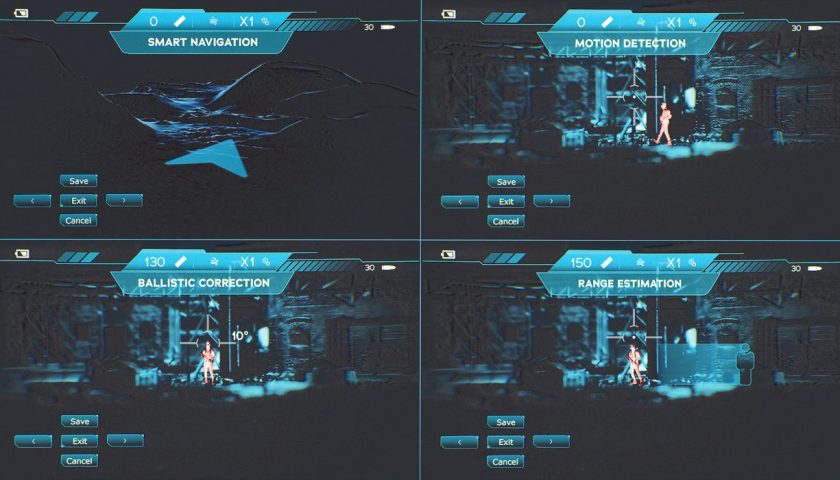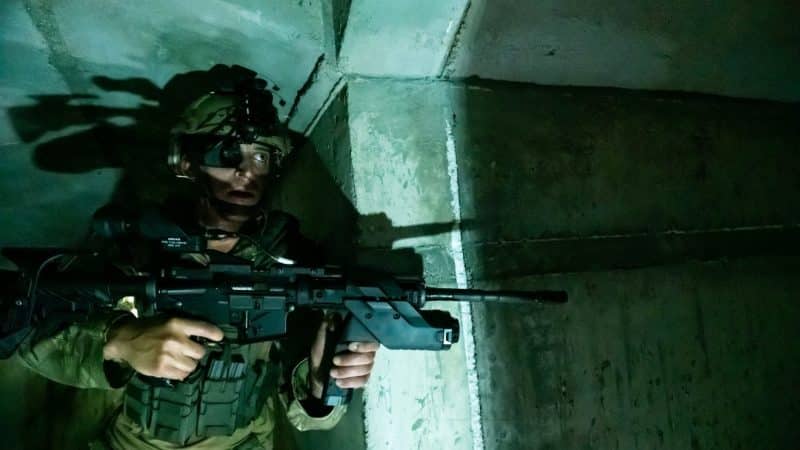Science fiction cinema is rich in futuristic weapons, capable of locating a hidden target, making a beginner an experienced Sniper, or coordinating and presenting information from the battlefield. If James Cameron imagined it, the Israeli company Elbit transformed this vision into a very real assault rifle, the ARCAS, which will be presented next week at the DSEI show in London. And in fact, the Assault Rifle Combat Application System indeed offers a promise of capabilities unparalleled with existing infantry weapons, even the most modern, by bringing together in a single piece of equipment, an assault rifle, an Electro-system low light or infrared optics, and a tactical information and command system, all controlled through a simple mini-joystick integrated into the weapon's aiming handle.
In fact, the infantryman equipped with the ARCAS receives, via the telescope or a monocular, numerous integrated information in the form of augmented reality about his environment, coming from his weapon, his Electro-optical system as well as other personnel equipped with ARCAS, and even other systems present on site, such as drones, all being merged by the weapon processing unit to be presented in the most appropriate manner. more effective to the soldier. Thus, thanks to a simple and ergonomic man-machine interface, the soldier can detect moving targets invisible even with a light intensifier, identify the origin of threats, and even correct his shot according to the parameters, so as to aim.

But these are only the initial features of ARCAS. Indeed, Elbit has designed the weapon around an open system, which will make it possible to simply and quickly extend its functionalities, by connecting it to the battlefield management system or to related systems, such as light drones. recognition, secondary electro-optical, sound or electromagnetic detection systems, as well as a non-exhaustive range of secondary systems with capabilities complementary to those of the weapon. In addition, unlike the US Army's IVAS, which rests a large part of the system on the soldier's helmet, most of the weight is here integrated into the assault rifle, and only the sighting eyepiece and augmented reality will weigh down the soldier's helmet. The system also integrates many useful features, such as geolocation and navigation, the possibility of recording the video of the engagement, as well as a very relevant augmented reality training function.
These new capabilities brought together in ARCAS will, therefore, be able to give back the advantage to Israeli, and by extension, Western, soldiers, while what was their strength for more than 3 decades, such as communication systems, geolocation or helmets equipped with night vision binoculars, are now becoming more widespread, including among non-state combatant groups. In fact, and beyond advanced cooperative engagement capabilities, it seems indeed decisive to give Western infantry forces sufficient technological added value to regain the upper hand on the battlefield, even if other countries , like China and Russia, are also developing very advanced infantry combat systems, such as the Russian Sotnik, an evolution of the Ratnik, which, like the ARCAS, will integrate cooperative combat and advanced detection capabilities.
If ARCAS does not offer new capabilities strictly speaking, since each of them already exists and has already been implemented, Elbit's tour de force was to manage to bring them all together in the handle before an assault rifle, and to implement them in a simultaneous and cooperative manner, what is more in a system geared towards scalability, without unduly weighing down the weapon and the infantryman. since the ARCAS in the assault rifle version weighs only 1 kg, batteries included, and the short-barreled special forces version does not exceed 850 gr. It remains to be seen how the system behaves in real operation. We can indeed fear that a mini-joystick will not cope well with the constraints of infantry combat, or that the capacities for cooperative engagement and communication between ARCAS could be easily jammed, or even altered by a cyber intrusion, or all simply used to locate carriers. That said, Elbit has some experience in all of these areas, including having developed the BMS battlefield management system used by the Israeli Army.
Last criterion, but it is important, the price of the system is currently unknown. We can easily imagine that it will far exceed the prices of current assault rifles, even the most advanced, since it is simultaneously a weapon, a system of cooperative engagement and a system simulation and training. But it is also important to keep in mind that a large part of the armies, notably the Western armies which may have the means to acquire such a system, already operate their own battlefield management system, which could as soon as then duplicate the functionalities of ARCAS. In addition, the recent experience of the Australian Army with the Elbit BMS risks weighing on the military's assessment of this system. Therefore, if ARCAS undoubtedly prefigures the capabilities of tomorrow's infantry weapons, there is still a long way to go before Elbit manages to make it more than an arms show star.

The rest of this article is for subscribers only
The Classic subscriptions provide access to
all articles without advertising, starting at € 1,99.
Newsletter subscription
Register for the Meta-Defense Newsletter to receive the
latest fashion articles daily or weekly

